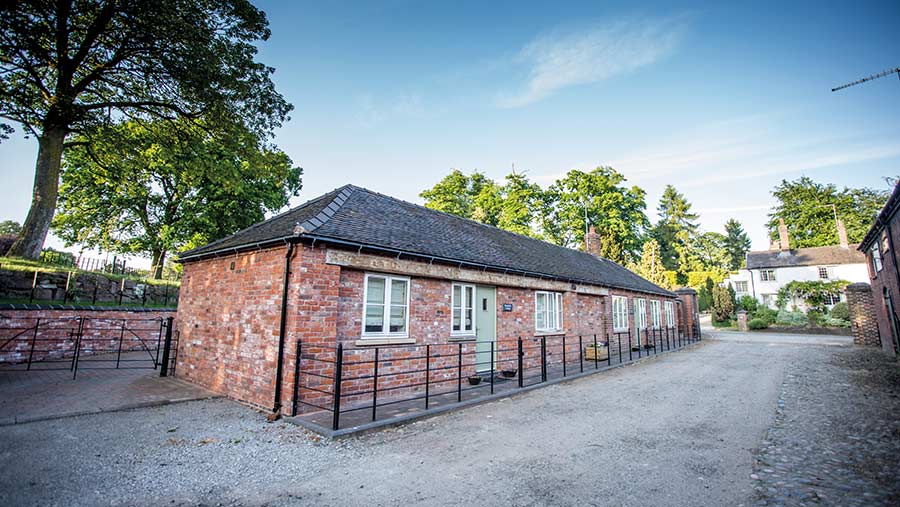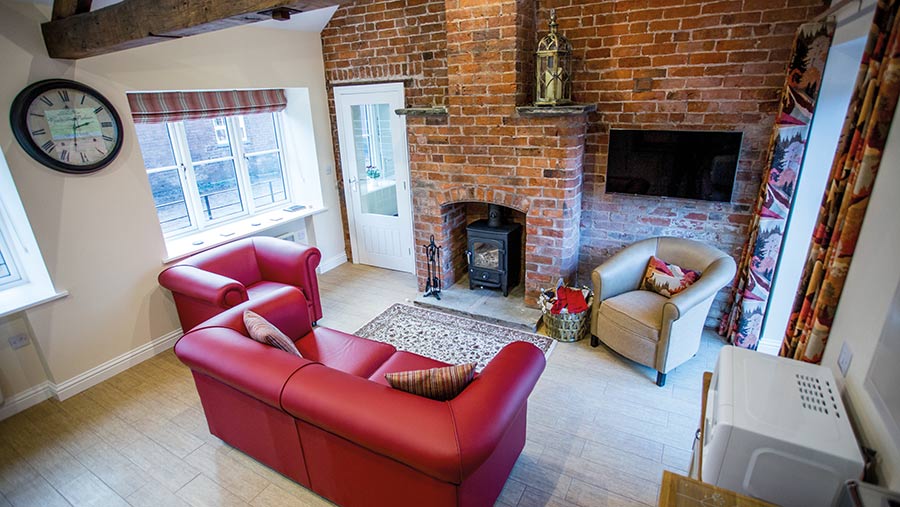How to benefit from the growing demand for holiday lets
Higher demand, coupled with concerns about post-Brexit support for agriculture, has made a farm diversification into letting cottages, barns, annexes and apartments more attractive.
Farmer and holiday let owner David Brown and Savills leisure director Simon Foster provide tips and pointers on setting up a venture.
Market trends
The market is strong and getting stronger, says Derbyshire-based farmer David Brown, who runs a holiday let business on Hoe Grange, his beef and sheep farm in the Peak District.
Mr Brown, a FarmStay director, suggests Brexit and concerns over Covid-19 have driven the appeal of UK countryside lets where people can distance themselves from others.
See also: So you want to… open a campsite?
However, he has also seen demand undergo a longer-term transition in recent years, from older couples on short breaks to younger families visiting for extended stays.
With the change there has also been a shift in demand towards higher quality lets.
Location

© Shraley Brook Media
In tourist hotspots, occupancy rates will be higher, however, the latest VisitBritain statistics suggest about 70% of successful holiday lets are outside prime locations.
For example, while beach holidays attract visitors in the summer, the season comes to an abrupt end when the temperatures drop. In addition, coastal places are often out on a limb and too far to be considered for long weekends or other short breaks.
Alternatively, a central area close to main routes where there is open countryside for walks might get more visits earlier or later in the season.
Planning
The first thing to consider is what level of consent the proposed venture will require. With an existing cottage it is usually covered under the “change of use” category.
A new-build or significant alterations that affect the scale, appearance or character of a property will need full planning permission.
Obtaining permission for converting existing buildings is usually straightforward. Planning is also more likely to be simple compared with siting new buildings on a greenfield site.
If building from scratch, the first consideration is the site. Planners often prefer a discreet location for new buildings, yet potential guests will want an open site with a view.
Whichever is chosen, approach the local planning officer early, before spending on expensive plans and surveys. Once the plans are given the initial go-ahead, permission for routing power, water and sewerage systems should be investigated.
Quotes can be high, with a simple 5m long connection for electricity costing about £12,000, Mr Brown says.
Property type
Demand has diverged and is strong for one- or two-bedroom properties for couples on short breaks, but the growth has been in very large houses offering group accommodation with 10-12 berths.
“We have several cabin-style buildings which are quick to construct. But from the moment they are built it is a depreciating asset. In contrast, a converted barn or holiday cottage appreciates and could provide a growing pension pot,” Mr Brown suggests.

© Shraley Brook Media
Furnishing
Wi-fi, smart TVs, a reliable mobile signal, dishwashers, washing machines and tumble dryers, along with top-quality beds and linen, are key, says Mr Foster.
Guests will be attracted to properties with hot tubs, open fires, log burners, Agas and Rayburns, but the costs of installing luxuries must be considered, says Mr Foster.
For example, hot tubs are labour intensive and tightly regulated. Water must be sampled twice a day, requiring someone on site, then the tubs must be disinfected and the water changed between parties.
Internal furnishings, however, must be high quality. Visitors will expect furnishing to be what is known in the sector as John Lewis standard.
Investment in cycle storage is also advisable. Guests with expensive bikes will bring them inside even if they are muddy, unless there is lockable storage outdoors.
Costs and margins
A good quality, three-bedroom cottage should bring in £30,000 to £40,000 a year, Mr Foster reckons.
Converting an existing cottage is the easiest approach, but could cost about £100,000. The cost rises to about £180,000 if a decent standard lodge is built.
Two large costs to bear in mind are letting agency fees, which can amount to 15-25% of income, and contract cleaners, which can take another 20%. Allow advertising to account for 3-4% of turnover, as it is an investment. With a sensible approach to costs, it is possible to achieve gross profits of about 30%.
Cashflow
Cashflow is a serious concern because bookings are paid for in advance. By September, even in an area with a long season, the cash income dries up because later visitors have already paid.
The price itself also drops at both ends of the season, so between September and March the cashflow will be negative, particularly where investments are being made in refurbishments over winter.
Insurance
Holiday lets will need to be covered by buildings and contents insurance, along with public liability and employers’ liability insurance policies.
The Covid-19 pandemic has reminded owners of the importance of business interruption insurance. Before the pandemic it was possible to buy guest cancellation insurance.
A lot of these policy products have been withdrawn and, where they remain, the price is high, at about 4% of the booking fee.
Inheritance tax warning
Those planning a move into the holiday lettings market should bear in mind that use as a furnished holiday let means the loss of business property relief for inheritance tax purposes, says Savills head of professional services Clive Beer.
All forms of capital taxation are under review, but for furnished holiday lets, inheritance tax is a particularly important issue to be aware of.
In the past, buildings converted for short stays that included certain services, such as the provision of bed linen, were viewed by HMRC as a trading business.
But HMRC has taken a harder line more recently and changes have gone against the taxpayer.
Holiday let property is now categorised as an investment business. That means it fails to qualify for inheritance tax relief and, on death, the owner’s estate would be liable for 40% of the property value.
To become a trading business, other services such as food and drink must be provided, effectively making the business a hotel. But do not assume that the services offered mean trading status has been achieved – seek professional advice to ensure valuable family assets are not lost to a tax bill.
Holiday letting tips
- Assess demand trends – they are different in different areas and are changing
- Get the accommodation quality right for your market
- Cost planning and conversion carefully
- Watch cash flow – it is very seasonal
- Consider tax and practicalities – trading or investment business?[end of panel]

Jayne Speed © Shraley Brook Media
Case study: Betley Court Farmhouse, Cheshire
Jayne and Frank Speed run a 73ha beef farm with bed and breakfast in the farmhouse and a burgeoning holiday let business.
Two farm buildings were converted to holiday lets six years ago, with a third due for completion this spring. Funding for the initial lets was achieved through selling land and moving out of sheep production.
The third has required a £100,000 investment, but has been part-funded with a local government grant which covered 40% of the construction costs.
The grant was through a now closed EU Leader programme, and securing the funding took time and a lot of paperwork. Mrs Speed suggests prospective holiday let owners should contact their local councils to assess what grants are available now the UK has left the EU.
The grant did not cover furnishings or equipment and a cautious approach to spending on internal fittings is advised because costs can quickly mount.
Mrs Speed estimates that costs for the kitchens amounted to £5,000 and the rest of the interiors were about £20,000. Planning costs also accounted for a big part of the project bills. With the farm in a conservation area, council planners were involved at every stage, insisting that windows and other external features met tight standards.
They also required surveys of soil, and local bat and badger populations, running into hundreds of pounds. An archaeological survey on the latest property has added £1,600 to the conversion bill.
While Mrs Speed urges a prudent approach to spending on the conversion, she says it is important to maintain a high standard of interior fittings and design.
“One common mistake made by holiday let owners is to fill properties with old cast-off furniture that they don’t want or they buy cheaply.
“But this creates a miserable atmosphere and will put off visitors if they see photos of dowdy, worn furniture.”
She also advises tiling floors rather than carpeting and using leather furniture. Photos in online travel agent (OTA) brochures of neatly arranged, standout interiors will attract visitors.
While she says OTAs are expensive – Betley Farm pays 18% of the booking fee to be listed – they do have advantages, particularly in the early phases.
OTAs set the market price for the lets and had helped recover money from guests who caused substantial damage to one of the properties.
Other valuable backing has been gained from FarmStay, which charges an annual fee, and joining the Professional Association of Self Caterers. She also recommends Visit Britain’s Pink Book – an advisory manual for holiday let owners.
